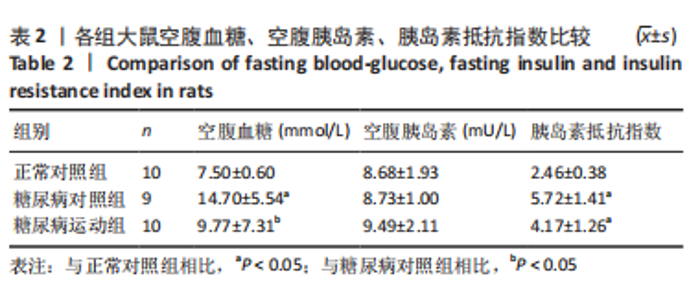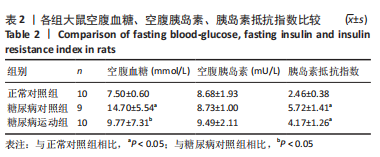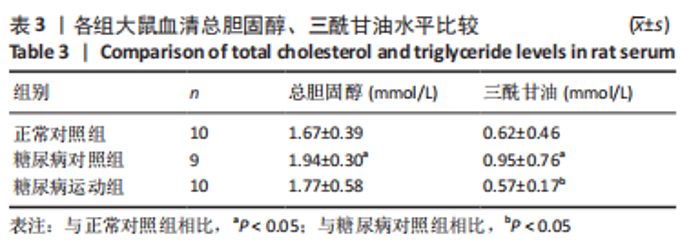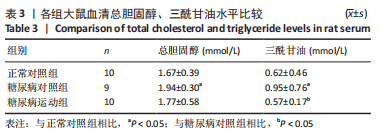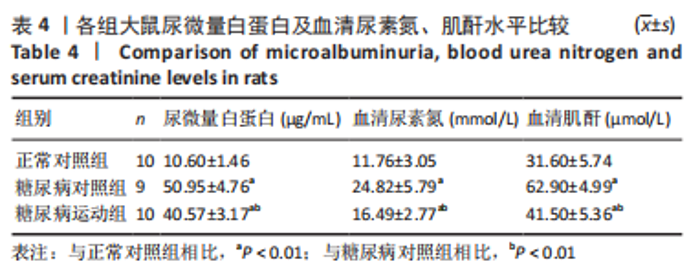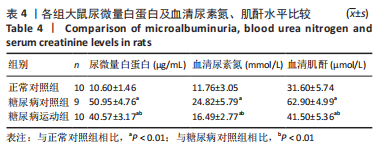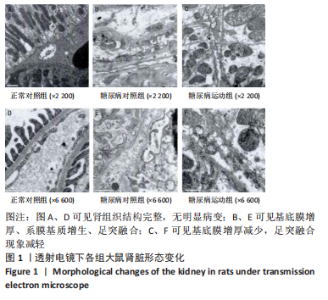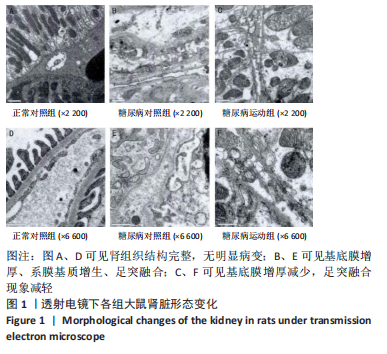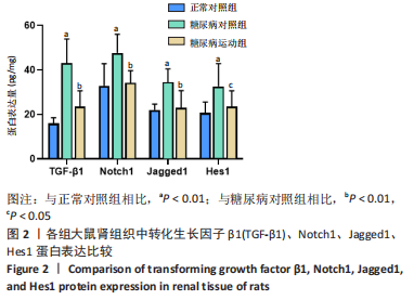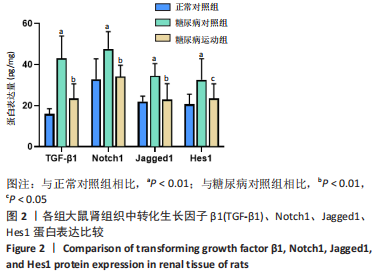Chinese Journal of Tissue Engineering Research ›› 2024, Vol. 28 ›› Issue (14): 2145-2151.doi: 10.12307/2024.322
Previous Articles Next Articles
Variation in renal function of type 2 diabetic rats undergoing aerobic exercise
Wu Yuzhen1, Sun Qing2, Liu Xia1, Zhou Yu1, Jin Qiguan2
- 1Hunan Provincial Key Laboratory of Physical Fitness and Sports Rehabilitation, Physical Education College of Hunan Normal University, Changsha 410012, Hunan Province, China; 2Physical Education College of Yangzhou University, Yangzhou 225127, Jiangsu Province, China
-
Received:2023-02-11Accepted:2023-05-05Online:2024-05-18Published:2023-07-28 -
Contact:Liu Xia, Professor, Master’s supervisor, Hunan Provincial Key Laboratory of Physical Fitness and Sports Rehabilitation, Physical Education College of Hunan Normal University, Changsha 410012, Hunan Province, China -
About author:Wu Yuzhen, Master candidate, Hunan Provincial Key Laboratory of Physical Fitness and Sports Rehabilitation, Physical Education College of Hunan Normal University, Changsha 410012, Hunan Province, China Sun Qing, Master, Physical Education College of Yangzhou University, Yangzhou 225127, Jiangsu Province, China -
Supported by:Hunan Provincial University Student Innovation Training Program Project, No. S202210542163 (to ZY); Natural Science Foundation of Changsha, No. kq2208166 (to LX); National Social Science Foundation of China, No. 22BTY103 (to LX)
CLC Number:
Cite this article
Wu Yuzhen, Sun Qing, Liu Xia, Zhou Yu, Jin Qiguan. Variation in renal function of type 2 diabetic rats undergoing aerobic exercise[J]. Chinese Journal of Tissue Engineering Research, 2024, 28(14): 2145-2151.
share this article
Add to citation manager EndNote|Reference Manager|ProCite|BibTeX|RefWorks
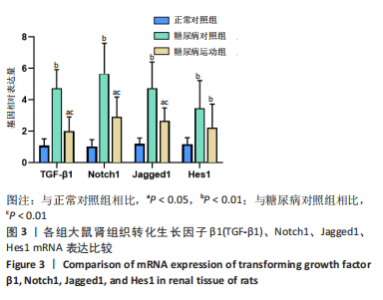
2.7 大鼠肾组织中TGF-β1、Notch1、Jagged1、Hes1 mRNA表达变化 如图3所示,与正常对照组相比,糖尿病对照组大鼠肾脏中TGF-β1、Notch1、Jagged1、Hes1 mRNA表达水平均极显著增加(P < 0.01);运动后TGF-β1、Notch1及Jagged1 mRNA表达水平极显著降低(P < 0.01),Hes1 mRNA的表达降低不显著(P > 0.05),TGF-β1、Notch1、Jagged1、Hes1 mRNA表达仍显著或极显著高于正常对照组。提示糖尿病能够使大鼠肾脏TGF-β1/Notch1信号通路上调,8周的游泳运动对其有显著的抑制作用。"
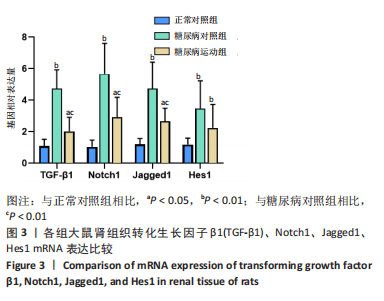
| [1] ZHOU Z, SUN B, YU D, et al. Gut Microbiota: An Important Player in Type 2 Diabetes Mellitus. Front Cell Infect Microbiol. 2022;12:834485. [2] Zhang XX, Kong J, Yun K. Prevalence of Diabetic Nephropathy among Patients with Type 2 Diabetes Mellitus in China: A Meta-Analysis of Observational Studies. J Diabetes Res. 2020;2020:2315607. [3] JING Z, HU L, SU Y, et al. Potential signaling pathway through which Notch regulates oxidative damage and apoptosis in renal tubular epithelial cells induced by high glucose. J Recept Signal Transduct Res. 2021;41(4):357-362. [4] 吴冰,王轩.基于Notch信号通路探讨枸杞多糖对糖尿病肾病大鼠肾纤维化的改善作用[J].陕西医学杂志,2023,52(3):267-272. [5] Gallenstein N, Tichy L, Weigand MA, et al. Notch Signaling in Acute Inflammation and Sepsis. Int J Mol Sci. 2023;24(4):3458. [6] MUKHERJEE M, FOGARTY E, JANGA M,et al. Notch Signaling in Kidney Development, Maintenance, and Disease. Biomolecules. 2019;9(11):692. [7] ZHOU B, LIN W, LONG Y, et al. Notch signaling pathway: architecture, disease, and therapeutics. Signal Transduct Target Ther. 2022;7(1):95. [8] SHARMA S, SIRIN Y, SUSZTAK K. The story of Notch and chronic kidney disease. Curr Opin Nephrol Hypertens. 2011;20(1):56-61. [9] 李佳,路华,王丽,等.lncRNA KCNQ1OT1表达下调对高糖诱导肾小球系膜细胞增殖、凋亡及纤维化的影响[J].山东医药,2022, 62(32):11-15. [10] MUREA M, PARK JK, SHARMA S, et al. Expression of Notch pathway proteins correlates with albuminuria, glomerulosclerosis, and renal function. Kidney Int. 2010;78(5):514-522. [11] TUNG CW, HSU YC, SHIH YH, et al. Glomerular mesangial cell and podocyte injuries in diabetic nephropathy. Nephrology (Carlton). 2018;23(Suppl 4):32-37. [12] MAJUMDER S, THIEME K, BATCHU SN, et al. Shifts in podocyte histone H3K27me3 regulate mouse and human glomerular disease. J Clin Invest. 2018;128(1):483-499. [13] HU C, SUN L, XIAO L, et al. Insights into the Mechanisms Involved in the Expression and Regulation of Extracellular Matrix Proteins in Diabetic Nephropathy. Curr Med Chem. 2015;22(24):2858-2870. [14] CHANG AS, HATHAWAY CK, SMITHIES O, et al. Transforming growth factor-β1 and diabetic nephropathy. Am J Physiol Renal Physiol. 2016; 310(8):F689-F696. [15] SWEETWYNE MT, GRUENWALD A, NIRANJAN T, et al. Notch1 and Notch2 in Podocytes Play Differential Roles During Diabetic Nephropathy Development. Diabetes. 2015;64(12):4099-4111. [16] 吴鹏,王亚东,方颖,等.肝豆灵抑制Notch信号通路干预铜负荷致肝纤维化大鼠肝脏上皮-间质转化[J].安徽中医药大学学报, 2018,37(6):79-84. [17] 隋淼,杨晓辉,于扬,等.沉默转化生长因子β1表达与抑制肾小管上皮细胞(HK-2)Notch信号通路的相关性研究[J].中国糖尿病杂志, 2017,25(8):697-702. [18] ALDAHR MHS, ABD EI-KADER SM. Impact of exercise on renal function, oxidative stress, and systemic inflammation among patients with type 2 diabetic nephropathy. Afr Health Sci. 2022;22(3):286-295. [19] SILVA VRR, KATASHIMA CK, LENHARE L, et al. Chronic exercise reduces hypothalamic transforming growth factor-β1 in middle-aged obese mice. Aging (Albany NY). 2017;9(8):1926-1940. [20] 孙晓娟,冯武龙,侯娜,等.有氧运动和白藜芦醇对2型糖尿病大鼠肾脏JAK2及TGF-β1的影响[J].中国应用生理学杂志,2020,36(3): 202-206+278. [21] GASPAR RC, MUÑOZ V, NAKANDAKARI SC, et al. 707-P: Physical Exercise Decreases Notch1 Activation and Reduces the Gluconeogenesis in Liver of Obese Mice. Diabetes. 2020;69(Supplement_1):707-P. [22] 吴裕颖,林洁,孙钰烨,等.不同剂量链脲佐菌素联合高脂饲料对大鼠血糖作用的研究[J].科教导刊(中旬刊),2018(5):68-69+72. [23] 任曙光,吴建华,巨英超.天麦消渴片对糖尿病模型大鼠血糖的影响[J].中医杂志,2011,52(19):1679-1681. [24] 张旖,张洪兵.8周游泳运动干预对高脂饲养小鼠炎性细胞因子和脂肪因子的影响[J].中国康复医学杂志,2020,35(3):301-305. [25] BEDFORD TG, TIPTON CM, WILSON NC, et al.Maximum oxygen consumption of rats and its changes with various experimental procedures. J Appl Physiol Respir Environ Exerc Physiol. 1979;47(6): 1278-1283. [26] 齐洁,张波,蒋丽,等.游泳运动对细胞自噬轴诱导生理性心肌肥大形成的影响[J].天津体育学院学报,2021,36(3):347-353. [27] 李泽华,吕卓,肖超妮,等.芍药甘草汤干预过敏性哮喘大鼠的尿液代谢组学研究[J].中华中医药杂志,2017,32(10):4416-4420. [28] 马飞,刘琳.肾衰宁片对单侧输尿管梗阻大鼠肾间质纤维化的改善作用及机制研究[J].陕西医学杂志,2022,51(6):654-658. [29] Son DJ, Hwang SY, Kim MH,et al. Anti-Diabetic and Hepato-Renal Protective Effects of Ziyuglycoside II Methyl Ester in Type 2 Diabetic Mice. Nutrients. 2015;7(7):5469-5483. [30] 张海华,李知行,刘霄潇,等.从络病理论探析针灸治疗胰岛素抵抗的研究思路[J].中国民族民间医药,2023,32(5):1-4. [31] MAGLIANO DJ, SACRE JW, HARDING JL, et al. Young-onset type 2 diabetes mellitus - implications for morbidity and mortality. Nat Rev Endocrinol. 2020;16(6):321-331. [32] 上官若男,朱斌,尚画雨,等.改善Ⅱ型糖尿病大鼠糖代谢运动模型的建立[J].中国实验动物学报,2017,25(3):275-280. [33] 李冀,李想,胡晓阳,等.中医药治疗糖尿病肾病机制研究进展[J].辽宁中医药大学学报,2020,22(9):8-11. [34] 李颖,林文弢,翁锡全.不同运动强度干预2型糖尿病模型大鼠的内脂素及糖代谢变化[J].中国组织工程研究,2020,24(26): 4196-4200. [35] 王丹丹.中性粒细胞/淋巴细胞比率、胱抑素C和β2微球蛋白联合检测在2型糖尿病肾病早期诊断及肾功能损害预测中的价值[D].新乡:新乡医学院,2022. [36] THIPSAWAT S. Early detection of diabetic nephropathy in patient with type 2 diabetes mellitus: A review of the literature. Diab Vasc Dis Res. 2021;18(6):14791641211058856. [37] FORMIGARI GP, DÁTILO MN, VAREDA B, et al. Renal protection induced by physical exercise may be mediated by the irisin/AMPK axis in diabetic nephropathy. Sci Rep. 2022;12(1):9062. [38] 朱洪竹,肖国强,朱梅菊.运动可能通过下调肾脏Notch-1信号改善Ⅱ型糖尿病大鼠肾功能[J].天津体育学院学报,2014,29(1):1-5. [39] 龚云,李敏.有氧运动对2型糖尿病大鼠肾脏的保护作用[J].中国体育科技,2021,57(2):44-48. [40] 董玉君.灸药结合对糖尿病肾病大鼠早期肾损害调控机制的实验研究[D].沈阳:辽宁中医药大学,2020. [41] Brophy TM, Coller BS, Ahamed J. Identification of the thiol isomerase-binding peptide, mastoparan, as a novel inhibitor of shear-induced transforming growth factor β1 (TGF-β1) activation. J Biol Chem. 2013;288(15):10628-10639. [42] Dong J, Ma Q. Myofibroblasts and lung fibrosis induced by carbon nanotube exposure. Part Fibre Toxicol. 2016;13(1):60. [43] WANG L, WANG HL, LIU TT, et al. TGF-Beta as a Master Regulator of Diabetic Nephropathy. Int J Mol Sci. 2021;22(15):7881. [44] ZHAO L, ZOU Y, LIU F. Transforming Growth Factor-Beta1 in Diabetic Kidney Disease. Front Cell Dev Biol. 2020;8:187. [45] 包春茶,李红丽,舒彬,等. 有氧耐力运动对老年小鼠肾纤维化及TGF-β1、E-cadherin表达的影响[J]. 中华物理医学与康复杂志, 2019,41(11):801-806. [46] 姚俊,郭林,曹建民,等.过度运动导致大鼠肾组织TGF-β1变化的研究[J].北京体育大学学报,2006(5):629-631. [47] 张晓飞.不同运动方式通过对2型糖尿病大鼠模型形成过程中血浆TGF-β1和肾脏TGF-β1、MMP-9/TIMP-1蛋白表达的影响以延缓肾脏纤维化的研究[D].武汉:武汉体育学院,2020. [48] EDELING M, RAGI G, HUANG S, et al. Developmental signalling pathways in renal fibrosis: the roles of Notch, Wnt and Hedgehog. Nat Rev Nephrol. 2016;12(7):426-439. [49] 刘兴梅,张莹莹,王圆圆,等.糖尿病小鼠肾组织中Notch1通过Akt/mTOR通路抑制自噬促进肾小管间质纤维化[J].中国病理生理杂志,2019,35(12):2169-2174. [50] DESHMUKH AP, VASAIKAR SV, TOMCZAK K, et al. Identification of EMT signaling cross-talk and gene regulatory networks by single-cell RNA sequencing. Proc Natl Acad Sci U S A. 2021;118(19):e2102050118. [51] LUO K. Signaling Cross Talk between TGF-β/Smad and Other Signaling Pathways. Cold Spring Harb Perspect Biol. 2017;9(1):a022137. [52] XIAO Z, ZHANG J, PENG X, et al. The Notch γ-secretase inhibitor ameliorates kidney fibrosis via inhibition of TGF-β/Smad2/3 signaling pathway activation. Int J Biochem Cell Biol. 2014;55:65-71. [53] WALSH DW, ROXBURGH SA, MCGETTIGAN P, et al. Co-regulation of Gremlin and Notch signalling in diabetic nephropathy. Biochim Biophys Acta. 2008;1782(1):10-21. [54] 谭禹洁,朱春玲,毛华雄.黄芩苷对单侧输尿管梗阻肾间质纤维化大鼠模型的治疗作用及机制研究[J].中国当代儿科杂志,2016, 18(4):365-371. |
| [1] | Wang Ji, Zhang Min, Li Wenbo, Yang Zhongya, Zhang Long. Effect of aerobic exercise on glycolipid metabolism, skeletal muscle inflammation and autophagy in type 2 diabetic rats [J]. Chinese Journal of Tissue Engineering Research, 2024, 28(8): 1200-1205. |
| [2] | Dai Yuexing, Zheng Liqin, Wu Minhui, Li Zhihong, Li Shaobin, Zheng Desheng, Lin Ziling. Effect of vessel number on computational fluid dynamics in vascular networks [J]. Chinese Journal of Tissue Engineering Research, 2024, 28(8): 1206-1210. |
| [3] | Sun Yuan, Wang Qingbo, Pi Yihua, Lu Chunmin, Xu Chuanyi, Zhang Yan. Effects of early and late aerobic exercise on right heart failure induced by monocrotaline in rats with pulmonary hypertension [J]. Chinese Journal of Tissue Engineering Research, 2024, 28(2): 177-185. |
| [4] | Wang Jingfeng, Wen Dengtai, Wang Shijie, Gao Yinghui. Atg-mediated autophagy, exercise and skeletal muscle aging [J]. Chinese Journal of Tissue Engineering Research, 2024, 28(2): 295-301. |
| [5] | Tang Liang, Wang Hexia, Wang Qingbo, Pi Yihua, Zhang Yan. Aerobic exercise modulates mitochondrial quality control system to reverse cardiac pathological remodeling in aging rats [J]. Chinese Journal of Tissue Engineering Research, 2024, 28(16): 2534-2541. |
| [6] | Deng Longfei, Zhang Yeting, Fu Yan. Aerobic exercise inhibits neuroinflammation and alleviates cognitive impairment in Alzheimer’s disease model mice [J]. Chinese Journal of Tissue Engineering Research, 2024, 28(14): 2209-2214. |
| [7] | Zhang Yeting, Li Chuikun, Wei Cuilan, Fu Yan, Zhang Feifei. Effects of aerobic exercise on adult hippocampal neurogenesis in Alzheimer’s disease mice [J]. Chinese Journal of Tissue Engineering Research, 2024, 28(13): 2068-2075. |
| [8] | Chen Guanting, Zhang Linqi, Li Qingru. Research hot spots and trends of exosomes in theranostic application for chronic kidney disease [J]. Chinese Journal of Tissue Engineering Research, 2024, 28(1): 86-92. |
| [9] | Wang Ji, Zhang Min, Yang Zhongya, Zhang Long. A review of physical activity intervention in type 2 diabetes mellitus with sarcopenia [J]. Chinese Journal of Tissue Engineering Research, 2023, 27(8): 1272-1277. |
| [10] | Jia Shengqi, Luo Wenlong, Tian Dingyuan, Zhang Xinhui, Cui Qian, Wang Chao, Pei Hanjun. Expression of mitochondrial sirtuin 3 in mice with acute renal ischemia-reperfusion injury [J]. Chinese Journal of Tissue Engineering Research, 2023, 27(8): 1172-1178. |
| [11] | Zhang Yan, He Ruibo, Wang Qingbo, Pi Yihua, Lu Chunmin, Xu Chuanyi, Ma Gang, Peng Peng. Effects of aerobic exercises with different load volumes on inflammatory response and insulin signaling pathway of skeletal muscle in obese rats [J]. Chinese Journal of Tissue Engineering Research, 2023, 27(8): 1237-1244. |
| [12] | Chen Guanting, Zhang Linqi, Li Qingru. Meta-analysis of the value of exosomal miRNA for the diagnosis of chronic kidney disease [J]. Chinese Journal of Tissue Engineering Research, 2023, 27(6): 970-976. |
| [13] | Tang Lu, Lin Haiqi. The power-law model-based analysis of aerobic exercise against Alzheimer’s disease in animal experiments [J]. Chinese Journal of Tissue Engineering Research, 2023, 27(35): 5695-5700. |
| [14] | Du Jia, Fu Yan, Fan Jia, Zhou Miaorong, Zhang Yeting. Aerobic exercise intervenes with beta-amyloid 1-42 induced changes in hippocampal synaptic structure and proteins in a rat model of Alzheimer’s disease [J]. Chinese Journal of Tissue Engineering Research, 2023, 27(33): 5256-5262. |
| [15] | Li Zhen, Liu Hongbao. Influencing factors and mechanism of nanoparticle renal targeting [J]. Chinese Journal of Tissue Engineering Research, 2023, 27(3): 453-460. |
| Viewed | ||||||
|
Full text |
|
|||||
|
Abstract |
|
|||||
